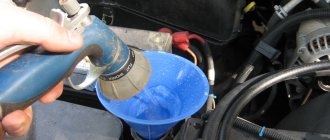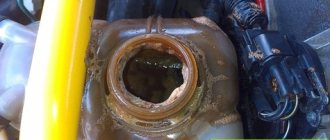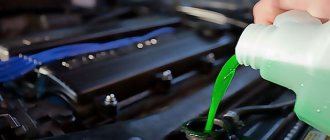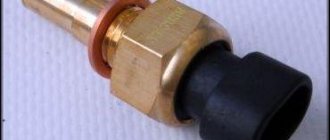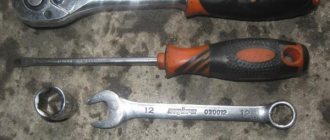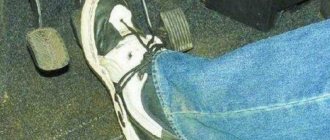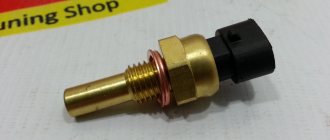The engine cooling system is an important part of every car, through which the normal operation of the engine is ensured. A significant part of the cooling system is devoted to refrigerant or coolant, which can be presented in the form of antifreeze (in most cases), antifreeze or distilled water.
During the operation of any car, including the VAZ 2107, it is important to promptly replace the coolant, which will improve the efficiency of the cooling system. In this issue, we will look in more detail at how to correctly replace antifreeze on a VAZ 2107, what is required for this and where to start.
Instructions for replacing antifreeze
Antifreeze, compared to water, is quite resistant to frost - it does not freeze. It is also not a source of scale, which means it does not clog the cooling system.
But, subjected to constant temperature influences and fluctuations, antifreeze loses its properties during operation:
- the boiling point decreases and accordingly becomes equal to the boiling point of water;
- The fluid may freeze, resulting in a cracked reservoir or cracked cylinder block.
For these reasons, it is necessary to change antifreeze at least once every six months. It is important to do this during seasonal car maintenance. Timely replacement of coolant will help avoid unpleasant consequences, unwanted repairs and unnecessary waste of money.
So, replacing antifreeze on a VAZ 2107 includes draining the antifreeze, flushing the cooling system (if necessary) and replacing the used coolant with new antifreeze or antifreeze.
You should first prepare the following materials and tools:
- canister with new antifreeze (6 liters);
- funnel;
- wrench “13”;
- open-end wrench “16”;
- key “12”;
- an empty container of 6-10 liters (a cut canister is often used);
- a clean rag made from natural fabrics;
- Protect your hands with gloves.
Drain
Draining antifreeze from the VAZ 2107 tank includes the following sequence of actions:
- Place the car on the inspection hole so that the front wheels of the car are higher than the rear ones;
- Move the lever (located on the dashboard) that supplies warm air into the cabin as far as possible to the right;
- Open the hood and unscrew the expansion tank cap;
- Unscrew the central radiator cap;
- Using a 16mm open-end wrench, unscrew the drain plug located on the cylinder block. Place a container prepared in advance, as liquid will begin to pour out. It may take up to 10 minutes to completely drain the spent fluid;
- Using a “12” wrench, unscrew the plug on the radiator drain hole, located in its lower part. A special bucket or container is used for draining;
- Remove the belt holding the expansion tank by hand. You should raise the tank as high as possible, thus draining the remaining antifreeze from the hose connected to the tank;
- After completing the procedure for draining antifreeze or antifreeze, the tank is installed in place, all drain holes are then closed and the cooling system must be flushed.
Flushing
Flushing the cooling system is an important procedure. It determines how effectively the VAZ 2107 engine will be cooled. A number of car owners believe that flushing the cooling system is a waste of time, and immediately fill in new antifreeze or antifreeze after draining the used fluid. This causes clean and dirty fluid to mix, negatively affecting performance.
You can flush the cooling system using either water or special products.
Cleaning OS with water
Flushing the cooling system with water is only allowed if there is no flushing liquid. The fact is that ordinary water contains impurities that contribute to the formation of scale. If the choice is water, it is better to use distilled water.
Sequencing:
- Water is poured into the expansion tank of a VAZ 2107;
- Let the engine idle for 30 minutes;
- After half an hour has passed, the engine is turned off and the water is drained;
- Repeat the procedure until the water drained from the system is as clean as the water being poured in;
- Stop the procedure after clear water appears.
Cleaning the OS with a special agent
You can also flush the cooling system with a product containing special impurities. This is a more expensive way to clean the system, but in the long term the most appropriate option, since the product removes from the tank:
- fat deposits;
- dissolves and removes scale from the tank;
- organic compounds.
Today, VAZ 2107 car owners use flushing fluids, the two main components of which are acids and alkalis. Car owners prefer LAVR, which costs from 700 rubles.
The sequence of actions when flushing the cooling system with a special liquid is no different from flushing with water. The only significant difference is the operating time of the motor, which is indicated on the canister of liquid.
After flushing the radiator tubes of a VAZ 2107 with LAVR, the positive result is obvious.
Bay
After the actions have been taken, it is time to fill in new antifreeze (or antifreeze, if such a decision was made by the VAZ 2107 car owner).
How to replace antifreeze on a VAZ 2107 injector? Sequencing:
- Open the radiator cap and insert a funnel into it;
- The following actions are carried out with the help of a partner. The plug is removed from the cylinder block and antifreeze is slowly poured in. At the same time, tighten the bolt, and as soon as the antifreeze flows out of the BC, the bolt is tightened. Such a maneuver will help eliminate the creation of air jams;
- Pour antifreeze into the radiator until it is completely filled;
- Pour antifreeze into the expansion tank until it reaches the radiator. Then screw on the tank cap;
- The tank is the last to be filled. The level corresponds to the norm. Upon completion of all procedures, the lid is screwed on;
- Start the engine and warm it up to operating temperature to check the proper operation of the cooling system. The cooling fan should work and the temperature should drop, which means the system is in working order.
We recommend: Modification of the VAZ 2110 thermostat
This completes the replacement of antifreeze in the VAZ 2107 injector. There is no need for special knowledge or special equipment to perform this procedure. It is enough to have a set of tools and decide on a place.
You should also pay attention to the fact that antifreeze, like antifreeze, is a toxic substance. Consequently, a number of safety measures are observed when replacing coolant on a VAZ 2107:
- Do not dump antifreeze on the floor in the garage or on the ground in the yard. The liquid is poisonous and can harm the human respiratory system;
- Protect your skin and do not allow antifreeze to get on your hands or in your mouth. A number of motorists check the nature of the fluid used by dipping their finger into the reservoir. The consequences may be poisoning or burns;
- If antifreeze gets on your hands, face, eyes, or mouth, rinse with a stream of cold water and take the victim to a specialist, or call an ambulance. Antifreeze, like antifreeze, is first of all a liquid hazardous to health, and only then a necessary component for the proper operation of a VAZ 2107 car;
- Do not have a snack while working on replacing antifreeze in the VAZ 2107. In this way, you can swallow the evaporated toxic liquid;
- Wash your hands after completing the antifreeze replacement procedure. This is done several times with running water, after which the skin should be protected with a special cream (especially important if antifreeze gets on the skin of your hands).
By adhering to the described recommendations, the driver of a VAZ 2107 car will protect both himself and others from unpleasant consequences, poisoning, burns, etc.
HOW TO DRAIN THE COOLANT CORRECTLY
Somehow, unnoticed, the time has come when it is necessary to replace the coolant on a VAZ 2114. You do not need to have a higher education in order to replace the antifreeze on a VAZ 2114. Even novice drivers can do it. Let's try to take a closer look at the question of how to drain the coolant. To do this, you need to stock up on empty containers for drained antifreeze, and prepare some tools.
- Wrenches for “8”, “13” and “17”;
- Screwdriver Set;
- Rags;
It will be useful: Fuses on a Chevrolet Cruze: where they are, diagram
It is best to drain the coolant from a “warm” engine and always with the interior heater radiator valve open. The further procedure for draining antifreeze from a VAZ 2114 will be as follows:
- Remove the engine protection so that the coolant can be completely drained;
- Remove the cap on the expansion tank;
- Place an empty container under the radiator and open the drain plug. It is necessary to ensure that the drained liquid does not flood the generator set. The draining process can take about 15 minutes. After draining is completed, wipe the plug with a rag and put it in place;
- The next step is to drain the coolant from the engine. Move the container under the engine drain plug and open it. It is found under the ignition module, which is best removed while draining the coolant. The process also lasts approximately 15 minutes. The cork is wiped with a rag and screwed into place. This completes the draining process.
Features of antifreeze and antifreeze
Let's start with the fact that Tosol is a type of antifreeze developed in the USSR. But as often happens with us, the name has become a household word and many liquids for car cooling systems are called Antifreeze.
Antifreeze and antifreeze are based on ethylene glycol (less commonly propylene glycol), distilled water and various additives. And the main difference between them comes down to the additive package.
Antifreeze is made from equal parts of water and ethylene glycol using traditional technology, which includes additives based on salts of inorganic acids.
But antifreeze already includes carboxylate additives (from salts of organic acids).
Thanks to additives, these liquids have anti-cavitation, anti-foam and anti-corrosion properties.
But the traditional manufacturing technology that is used in the production of Antifreeze is already somewhat outdated due to additives. Additives made from salts of inorganic acids cease to perform their functions over time. Antifreeze has a longer additive life.
At the same time, the additives themselves work differently . The anti-corrosion additive in Antifreeze covers all metal elements of the system with a thin protective layer. But this same layer makes it difficult to remove heat.
In antifreeze, this layer is much thinner than that of Antifreeze, and at the same time it covers only those elements of the system that are susceptible to corrosion.
If you look at it in general, then in a debate - antifreeze or antifreeze for VAZ, in terms of its performance properties, antifreeze wins. But not everything is so simple and a lot depends on the VAZ model itself.
The fact is that most domestic cars are primarily designed to work with Antifreeze. It is the main liquid, although the operating instructions often indicate that antifreeze can also be used.
Purpose of antifreeze
There is nothing difficult about completely draining the coolant from the car system. But before starting this process, you need to familiarize yourself with the structure and operating principles of the system as a whole.
Antifreeze and antifreeze mean non-freezing technical fluid used in the car system not only to cool the engine and other units, regardless of climatic conditions, but also to lubricate certain elements and protect them from corrosive changes. Like all other technical fluids in a car, antifreeze deteriorates over time and loses its properties, which means that this material must be regularly replaced.
According to the rules, it is recommended to change the coolant at least once every three years, however, these dates may shift depending on how intensively the vehicle is used. If you constantly neglect this simple rule, then the recycled liquid will cease to function fully. The consequence of this will be constant overheating of the engine and all adjacent systems, as well as the appearance of corrosion.
Some craftsmen, in order to save money, dilute antifreeze with water, without even suspecting the serious damage they thereby cause to their own car. Thus, adding water causes the pump to jam , which does not receive the required amount of lubricant, as a result of which the belt may break or the gear teeth may be damaged. As a result, the distribution valves and the entire piston system as a whole may fail, so the decision to add water to the antifreeze is clearly wrong, and its consequences can be extremely disastrous.
Why does it flow
There are many options for why coolant may leak. It is very difficult to determine this location of the leak. The main ones are:
- View all pipes; perhaps one of the clamps is not clamped properly.
- The pipe itself has cracked from time to time.
- The cause of mechanical damage is in the radiator. This can be corrected by welding or gluing. You can determine the location of the leak in the radiator using dismantling or gel sealant.
- Water pump. Over time, the pump, like any other part, can wear out and leak. In this case, the pump will have to be replaced.
- The element leaks out from under the head. It is better to correct such a leak at a service center, since this will require disassembling the engine.
- When the element leaks directly into the vehicle's cabin. This can be determined by lifting the floor mat on the driver or passenger side.
How to replace antifreeze on a VAZ 2107
Now it's time to fill in new antifreeze. To do this, open the radiator cap and insert a funnel there. Remove the plug from the cylinder block and ask your partner to pour in antifreeze in small portions. At this time, tighten the bolt, and as soon as antifreeze flows out of the BC, immediately tighten the bolt. This is necessary to prevent the creation of air jams. Then pour antifreeze into the radiator until it is completely filled. Next, without screwing the cap on the radiator, pour antifreeze into the expansion tank until it reaches the radiator. After this, screw on the tank cap.
ABOUT THE PRINCIPLE OF OPERATION OF THE COOLING SYSTEM
The engines of the VAZ 2113, 2114 and 2115 family of cars operate in conjunction with a closed-type liquid cooling system. There are special channels in the engine cylinder block through which coolant, or coolant for short, circulates, which is used as antifreeze, antifreeze or water. Moving through the block, the coolant takes away excess heat and enters the radiator for cooling.
Studies of the operation of internal combustion engines have shown that the normal temperature for optimal engine operation should be 90 0 C. To maintain a constant such temperature, a thermostat is installed in the system. During engine operation, it redirects the coolant flow to the radiator for cooling, or again to the cylinder block.
Forced coolant circulation in the system is provided by a pump, which is driven by a drive belt from a pulley on the engine crankshaft. The heated coolant flows through the pipes into the radiator for cooling. It comes from the flow of oncoming air, and if it is not enough, then the electric fan turns on. Also, hot coolant enters the heater radiator to heat the engine compartment, and its excess during thermal expansion is sent to the expansion tank.
Replacing the coolant: why is this event being carried out?
The cooling system of modern cars is presented in the form of a liquid-type system, which means heat is removed from the car engine through liquid. The coolant circulates through the system, removing heat from the engine and cooling in the radiator. The pump or water pump redirects the cooled portion of the liquid to the engine to cool the latter again. The heat exchange process occurs continuously while the car engine is running and the pump is rotating.
We recommend: Procedure for adjusting valves on a VAZ 2107 carburetor
As the coolant is constantly exposed to different temperatures, it loses its properties over time. When antifreeze loses its properties, its boiling point decreases and approaches the boiling point of ordinary water. Most often this happens after a mileage not exceeding 60 thousand km. It is at this mileage that it is recommended to completely replace the antifreeze in order to avoid unforeseen and undesirable consequences. Before we begin the replacement, let’s find out how to properly drain antifreeze from a VAZ 2107.
How to properly drain used fluid
To drain antifreeze from a VAZ 2107 car, simply opening the tap is not enough, through which all the liquid will flow out of the system. Both antifreeze and antifreeze are toxic substances, so when working with them you should follow safety rules. Before draining, it is necessary to prepare a container into which the waste will be drained. The volume of such a container should not be less than 10 liters. The best option for such purposes is a trough or basin.
It is easy to carry out the work without an inspection hole, so it is recommended to install the car on the handbrake, and then place a trough or other container under the engine. We begin the process of draining the liquid, for which the following steps are performed:
- The first step is to open the hood, then unscrew the cap from the expansion tank. This is necessary in order to reduce the pressure in the system, thereby speeding up the process of draining the waste. It is also recommended to unscrew the cap on the radiator.
- It is necessary to open the heater tap from inside (move the lever to the “warm” position) in order for the coolant to drain from the heater radiator.
- The next step requires unscrewing the plug bolt, which is located at the bottom of the cylinder block.
- Now you can start unscrewing the drain plug. located on the radiator. After unscrewing it, drain all the used fluid into a container, which may take up to 10 minutes.
- At the next stage, you need to loosen the fastening of the expansion tank, and then lift the latter up to drain the remaining liquid from it. How much antifreeze will be in the system depends on how often the car owner added it there.
The capacity of the cooling system of VAZ-2107 cars is just over 8.5 liters, so you need to wait until the last drop flows out. While the antifreeze is draining, you can prepare a new canister that will be poured into the system.
It is important to know! It is strictly forbidden to start the car when there is no antifreeze in the system.
Features of filling coolant
During the process of replacing the coolant, you can perform the procedure of changing the sealant or clamps on the pipes if leaks were noticed earlier. To do this, it is necessary to remove the pipes, check their integrity, remove any old sealant, then apply a new one and put it back in place. If the pipes have obvious defects, then it is better to replace them immediately, so that after a while the new antifreeze does not end up under the car.
Before adding a new type of antifreeze, you should tighten the drain bolt on the cylinder block, as well as the lower plug on the radiator. Remember to complete these steps before you begin the pouring process. We recommend doing the filling as follows:
- Before filling, unscrew the sensor located between the spark plugs of the 3rd and 4th cylinders, slightly higher, from the cylinder block. This will prevent the formation of an air lock in the car's cooling system;
- now antifreeze is poured into the VAZ 2107 through the hole in the radiator until it flows out of the hole from the sensor in the block in an amount of about 5 liters;
- screw the sensor into place and continue pouring;
- It is necessary to pour until the radiator is completely filled. You can additionally move the pipes to release air from them;
- After filling the radiator, you need to close its cap and add coolant into the expansion tank to the range from “MIN” to “MAX”.
It is important to know! Replace the coolant on your car only when the engine is cool. Antifreeze is very toxic, so inhaling its vapors can affect your well-being.
On VAZ 2107 cars, the injector and carburetor differences in the cooling system are insignificant. The only difference is that the temperature control system sensor is installed on the injector and the throttle body is heated. The carburetor engine of the "seven" has a more simplified cooling system, but they work on the same principle. There is no difference in the coolant capacity of the cooling systems of carburetor and injection engines. Above is a video about how antifreeze is replaced on a “seven”.
WHAT'S IN THE COOLING SYSTEM
Antifreeze or antifreeze is used to cool engines. Let's find out in more detail about these liquids, and what is better to use antifreeze or antifreeze on the VAZ 2114. This separate name for coolant is used only by drivers in Russia and CIS countries. At their core, they are the same chemical substance. However, there are still slight differences in these substances, which affect the operation and components of the engine.
Experts recommend pouring antifreeze into the cooling system of foreign cars, while antifreeze is more suitable for cars of the Russian automobile industry. Replacing antifreeze with antifreeze is possible, there will be no harm from it. You just need to thoroughly rinse the cooling system with distilled water. The question of which antifreeze is best to pour into a VAZ 2114 needs to be decided by the car owner himself.
A few words about the advantages of antifreeze over antifreeze:
- Higher cooling efficiency;
- Increased service life;
- More effective protection of aluminum parts at high temperatures;
- The pump resource increases;
- Higher ability to protect against cavitation in cylinders;
- Better compatibility when working with rubber, plastic and other materials of cooling system parts;
- Higher environmental friendliness in use.
When purchasing coolant, the buyer wants to know at what temperatures it is intended to operate. The consumer is informed about this by the marking on the coolant container. If there is the inscription “Antifreeze 65”, then this liquid can be used in conditions of ambient air temperature not lower than -65 0 C. You can also independently check the density of the liquid with a hydrometer. It is allowed to add distilled water to the coolant during vehicle operation, since it is this that evaporates at high temperatures.
Timing for replacing coolant in VAZ 2107
The purpose of the coolant in the VAZ 2107 is to remove excess heat from the car’s engine. Indeed, during operation, many parts of an internal combustion engine reach temperatures of 300 degrees C. If the engine is not cooled in time and sufficiently, it will fail. Coolant solves this problem; it is supplied to a running engine, flows through the channels, thus taking away excess heat from the internal combustion engine.
After heating, the coolant goes into the central radiator, which is constantly blown by the fan. After cooling in this unit, the liquid returns to the engine cooling channels. This is the procedure for continuous liquid cooling of the VAZ 2107 engine.
The general principle of operation of the VAZ 2107 cooling system can be studied using the diagram below.
How to understand what kind of coolant is required for a VAZ 2107 - antifreeze or antifreeze? Since we are talking about Russian cars, we should distinguish between concepts such as antifreeze and antifreeze to clarify concepts.
It should be noted that such division and differentiation is accepted only in the Russian Federation. To answer this question, you must first understand: what is coolant?
We recommend: DIY car dent repair without painting
So, the basis of the coolant is ethylene glycol, less often propylene glycol. Special additives are added to it, which protect against corrosion. Each manufacturer adds different types of additives.
Let us differentiate the coolants available on the modern market according to additive production technologies:
- traditional, in which additives are made from salts of inorganic acids: silicates, nitrites, amines, phosphates;
- carboxylate, additives are made from organic carbonates;
- hybrid, consists of a mixture of organic carbonate additives and inorganic salts (in smaller quantities, including phosphates or silicates).
So, the main difference between antifreeze and antifreeze is that coolant made using traditional technology is called antifreeze, while coolant made using carboxylate technology is called antifreeze.
Advantages and disadvantages of using antifreeze
Pros:
- protective film. Thanks to the inorganic salts contained in antifreeze, a protective film is created on the surface of the cooled parts, protecting them from corrosion. The film reaches 0.5 mm. In the picture below you can see how antifreeze creates a protective layer, the disadvantage is that it interferes with heat removal;
- color change. If the driver forgot to change the coolant, a clue to the need for the procedure will be the color of the liquid, which is easy to notice just by looking into the car's expansion tank. The changes are that as the antifreeze loses its useful properties it becomes darker, and completely unusable antifreeze cannot be distinguished from tar;
- affordable prices. Coolant produced using traditional technology is 3 times cheaper than antifreeze.
Disadvantages of antifreeze:
- replacement frequency. Antifreeze has a short lifespan, becoming unusable after 50 thousand kilometers;
- negative impact on aluminum parts. The additives used to create antifreeze negatively affect the aluminum surfaces in the main radiator (which significantly reduces its service life);
- due to the tendency to form condensation, it negatively affects the water pump of the VAZ 2107, as a result - premature wear of its impeller.
Let's look at the advantages and disadvantages of using antifreeze
Pros:
- service life is longer - 6 liters of antifreeze is enough for 150 thousand kilometers;
- temperature selectivity - due to the presence of carbonate additives, antifreeze more actively protects the engine surface that is heated the most;
- antifreeze does not interfere with heat dissipation, and also protects corrosion areas with the help of local layers;
- long engine operation due to temperature selectivity and timely engine cooling with antifreeze;
- there is no condensation, which means antifreeze cannot damage the radiator and water pump of the VAZ 2107.
The disadvantage of antifreeze is obvious - its high cost. In terms of price, it is on average 3 times higher than antifreeze.
Which antifreeze is best for me?
It is important to remember that the further operation of your car’s engine depends on the quality of the coolant. The choice of coolant should be treated very carefully. First, you should study the instructions that came with your car. Often, manufacturers advise which coolant marking should be chosen.
.
A universal option would be organic antifreeze G12 plus, since it is inexpensive, environmentally friendly, and mixes perfectly with all existing antifreezes (even with the newfangled G13). Antifreeze is often sold as a concentrate and must be diluted with distilled water (recommended in a 50 to 50 ratio).
During engine operation, almost all of its parts are exposed to high temperatures. To cool them in a car, including the VAZ 2114, a special liquid (antifreeze) is used. It circulates through the system and is cooled in the radiator by oncoming air. Used antifreeze must be periodically drained from the tubes and new one filled in.
Replacing fluid on a VAZ-2107
Carrying out all the work on this car is not that difficult. Tools you will need:
- Key to 13;
- Key for 30 (possibly);
- Screwdriver;
- Drain container;
You should also take care of purchasing new fluid. In this car, its quantity in the system should be 8.65 liters.
The work is carried out in the following order:
- The car is placed on the platform and time is given to cool down (if the engine is warm);
- Remove the caps from the radiator filler neck and expansion tank. Also in the cabin, on the heater control panel, we move the lever to heating, thereby opening the heater radiator tap;
- Unscrew the drain plug at the bottom of the radiator. On older models there is no such plug, so on them the temperature sensor is unscrewed with a 30 key. There is also a drain plug on the engine, which we also remove. We collect the leaking liquid into a prepared container;
- After draining, install all plugs in place;
- We wash the system. To do this, distilled water or a special detergent is poured into it. In order to completely fill the system and displace the air, remove the pipe going to the intake manifold. As soon as water or liquid comes out of it, we put it in place;
- We start the engine so that it flushes the system through circulation;
- Drain the water through the plugs. Fill in new coolant. We start the motor for circulation. Then we are interested in the amount of liquid in the system and, if necessary, add it to the expansion tank to the required level.
Cooling system elements
The process of draining coolant from the radiator
In order to understand how and why it is necessary to drain the coolant, you need to have a little understanding of the design of the car and the cooling elements. Also, you need to know how the coolant circulates in the engine and have an idea of the places where it can be drained.
So, let's look at the complete diagram of the engine cooling system and how the coolant circulates:
Cooling system diagram
1 – element in the form of a plug for the expansion tank; 2 – expansion tank; 3 – hose for draining liquid from the pipe; 4 – hose passing between the radiator and the expansion tank; 5 – hose leading from the radiator; 6 – tank to the left of the radiator; 7 – aluminum tube; 8 – plug systems; 9 – tank to the right of the radiator; 10 – drain plug; 11 – middle of the radiator; 12 – casing for electric fan; 13 – plastic wings of the electric fan; 14 – electric motor; 15 – toothed pump pulley; 16 – pump impeller; 17 – camshaft drive belt; 18 – engine block; 19 – pump pipe; 20 – radiator hose with supply function; 21 – heater radiator hose with drain function; 22 – hose supplying coolant to the throttle pipe; 23 – exhaust pipe; 24 – hose for refilling; 25 – heater radiator hose with supply function; 26 – thermostat; 27 – coolant temperature sensor; 28 – coolant level indicator sensor.
Coolant drain options
There are two options for draining coolant from the system. They depend on what operations the motorist intends to perform with the car. So, let's look at both options separately.
Draining without removing the engine
This method is often used to replace coolant in the system, as well as to change cooling elements. The procedure is quite simple. Let's look at how to properly drain the liquid from the cooling system completely:
- We find the cooling system plug on the cylinder block.
Location of the coolant drain plug on the cylinder block
Remove the expansion tank cap
Unscrew the plug on the radiator to drain the coolant
Installation of faucet
Drain faucet
For the convenience of subsequent draining and repair work, you can install a faucet. Moreover, you have already unscrewed the standard plug.
Draining with engine removal
The second method is easier than the first and is used when the engine is planned to be removed. Let's consider the sequence of actions aimed at draining coolant from the system:
- Unscrew the plug on the expansion tank.
- We unscrew the plugs from the cylinder block and radiator.
- Next, when the liquid has flowed out, you need to unscrew the pipes leading to the radiator.
- Of course, some liquid remains in the system and must be drained completely. This can be done in two ways: by blowing it out with a compressor or by disassembling the engine.
Why do you need to drain the coolant?
This “slurry” has already served its term
Let's look at the main reasons why you will need to completely drain the coolant from the system:
- Development of a full resource of use . It is recommended to carry out once every 90-100 thousand km. This is due to the fact that the coolant, due to a constant temperature difference, which is its operating temperature, loses its technical and physicochemical properties. After such a mileage, it can no longer effectively provide cooling of the engine and its elements, which can lead not only to failure of the thermostat and pump (most often these are the spare parts that suffer), but also to boiling of the engine, which can have unpleasant and material consequences .
- During engine overhaul . When the engine is dismantled for major repairs, the coolant will need to be completely drained.
- Replacing the radiator will also require draining the coolant completely from the system, but it is done according to a simplified option (the second one, which is indicated above).
- Replacement of other individual elements that will require draining the coolant from the system.
It will be useful: Which brake pads are better: manufacturer ratings
Coolant functions
- Maintaining normal temperature during engine operation (injector).
- Maintaining low temperature in the gearbox (hydraulic fluid that needs to be poured into the automatic transmission).
- Interior heating in winter. Pouring antifreeze provides heat to the car by passing through the heater. The motor heats the liquid, and the fan blows air and transfers heat. Thus, heated air enters the cabin.
Antifreeze in the VAZ 2107 should be replaced every 45,000 km. or once every two years, whichever comes first. Because over time the quality deteriorates and this leads to adverse consequences.
Radiator cap open
Replacement features
If there are small leaks in the engine cooling system and the car owner periodically adds water or antifreeze from different manufacturers, the old coolant may take on a rusty color. Foreign bodies may appear in the form of small chips and rust, which, by the way, can lead to failure of the main elements of the cooling system, water pump, thermostat, heater tap, etc.
Flushing the VAZ 2110 cooling system
In this regard, when replacing old antifreeze in this condition, it is necessary to flush the system. This can be done using different additives, which is not always beneficial for the cooling system. Low-quality cleaning additives may not only not help, but also damage the components of the cooling system. Therefore, it is necessary to use high-quality additives and not skimp.
A detailed overview of stove malfunctions is presented here: https://vazweb.ru/desyatka/otoplenie/neispravnosti-pechki.html
You can also flush the system naturally with distilled water. After draining the old antifreeze, water is added. The car idles for 10-15 minutes, then it is drained again and new antifreeze is added. If there is severe rust, you can repeat the procedure.
There is a cheaper and easier way; you can simply flush the system with plain water by opening the radiator and engine caps in sequence. Those. the engine cap is unscrewed and water is spilled through the expansion tank. Then the engine plug is closed and the radiator drain plug is opened. Do only in this sequence, since the radiator is at the lowest point and all the water will pour out.
- Author: ratico19
Rate this article: (4 votes, average: 5 out of 5)
